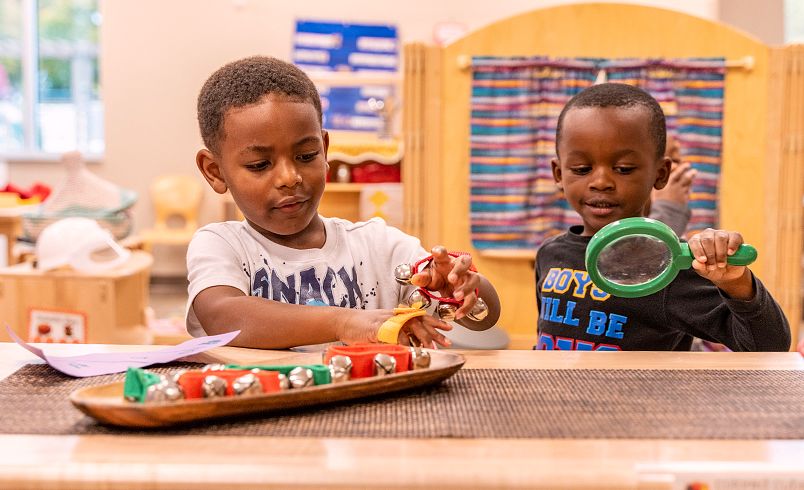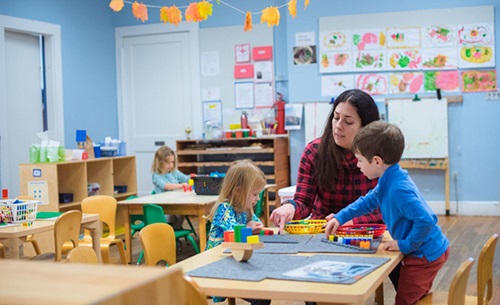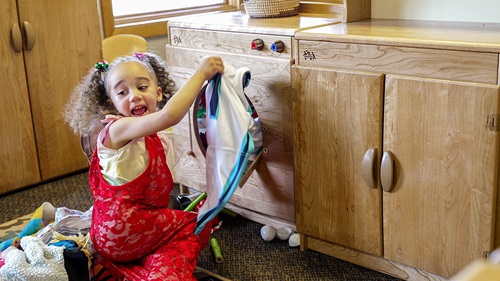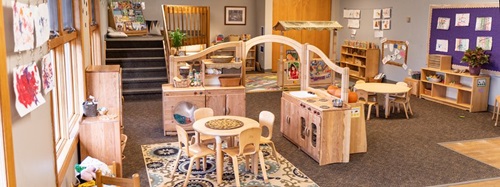Creating Indoor Environments for Young Children
| March 2011

HOW TEACHERS CAN CREATE EFFECTIVE LEARNING ENVIRONMENTS
The components of a learning environment are many and can be overwhelming. What should an environment for young children look like? How do you create an environment that supports learning and meets children’s basic needs? Below is a brief description of the most important components needed to make an effective learning environment for young children.
ENVIRONMENTS FOR YOUNG CHILDREN STIMULATE LEARNING
Environments for young children should provide multiple sources of stimulation to encourage the development of physical, cognitive, emotional, and social skills. As you plan your environment, be sure to include the following:
Places for developmentally appropriate physical activities. Environments should provide children with opportunities for a lot of developmentally appropriate physical activities. Young children are physical beings. They learn most effectively through total physical involvement and require a high level of physical activity, variety, and stimulus change (Hale, 1994).
Opportunities for concrete, hands-on activities. Young children need hands-on activities—playing in water, building mud pies, making things out of wood, putting a doll to bed, etc. They also need lots of ways to practice and integrate new experiences into existing mental structures—dramatic play, drawing, taking photographs, using language, and making things with blocks.
Change and variety. Children seek out a constant change of stimuli—scenery, textures, colors, social groups, activities, environments, sounds, and smells. The more our children spend time in our programs, the more variation and stimulation they need.
Color and decorations. Color and decorations should be used to support the various functional areas in the classroom and center, provide needed stimulus change and variety, and develop different areas and moods in the room. Vibrant colors such as red, magenta, and yellow work well in the gross motor area; soothing blues and green are good color choices for hands-on learning centers; and whites and very light colors are good for areas that need lots of concentration and light. Soft pastels and other gentle hues, on the other hand, work well in reading areas and other low intensity activities. Decorations should follow the same pattern, with an additional emphasis on changing them often, and providing order around topics, projects, and themes.
MATERIALS AND EQUIPMENT CONTRIBUTE TO THE OVERALL ENVIRONMENT AND PROGRAM PHILOSOPY
The success of an early childhood environment is not dependent upon aesthetics and design alone. The materials and equipment given to the children are just as important to learning as the physical space of the classroom. The following materials and equipment can be added to any early childhood environment.
Soft, responsive environments. Children who spend most of their day in one environment need surfaces that respond to them, not hard surfaces that they must conform to. Sand, water, grass, rugs and pillows, and the lap of a caregiver respond to a child’s basic physical needs (Prescott, 1994).
Flexible materials and equipment. Children can use sand, water, or play dough in a variety of ways, depending on their maturity, ability, past experience with the materials, interest, and involvement. A jigsaw puzzle, on the other hand, has only one correct solution. Legos® and tinker toys have specific physical qualities that must be adhered to, but are also flexible enough to allow a range of creative activities. Programs should include lots of materials that have an abundance and variety of uses to give children a sense of creativity and control (Wardle, 1999).
Simple, complex and super complex units. According to Prescott (1994), learning materials can be simple, complex, or super complex. Simple materials are those with essentially one function, complex those with two, and super complex, those with more than two. For example, a pile of sand is a simple unit. If one adds a plastic shovel to the sand it becomes a complex unit. Adding a bucket of water or collection of toy animals to the sand and shovel creates a super-complex unit. The more complex the materials, the more play and learning they provide (Wardle, 1999).
STRATEGIES FOR SMALL SPACES
Programs with little space must change their areas often and find creative ways to use community areas such as parks and recreation facilities for gross motor activities. With a little creativity, small spaces can work out very well. For example, I once observed a very well planned and supportive early childhood environment designed under the bleachers of a high school! Lofts were built, there were cozy reading areas, and each Head Start child had a place of their own. When I was teaching in Kansas City, we walked across the street to use the Jewish Community center's gym and swimming pool. When using community facilities, be sure that playgrounds and other equipment are safe and developmentally appropriate for the children in your care.
PRIVATE PLACES
Because so many child care facilities have limited space, it can be challenging to respond to the uniqueness of each child within a collective environment. Young children have unique personalities and needs that require us to respond to them as individuals, not as members of a group. The environment must be responsive to this need. Ease of cleaning, maintenance, supervision, cost, and adult aesthetics should not detract from providing spaces children feel are designed for them. Children need to have private areas, secluded corners, lofts, and odd-shaped enclosures. Individual cubbies for each child's clothes and belongings, photographs of home and family, and at least a couple of secluded areas where two or three children can gather allow children opportunities to maintain their individuality and break away from the group to avoid over-stimulation.
EARLY CHILDHOOD ENVIRONMENTS SHOULD BE FUNCTIONAL FOR BOTH CHILDREN AND TEACHERS
Unlike traditional classrooms, early childhood environments need to support both basic functions and learning activities. Look around your classroom from a child's perspective. Are toilets, sinks, windows, faucets, drinking fountains, mirrors, towel racks, chairs and tables, toothbrush containers, and bulletin boards at the child's level and child-sized? Are classrooms, bathrooms, kitchens, and eating areas close together so that children can develop self-help skills and important autonomous behaviors? Like children, teachers also need to have spaces that are functional. Teachers need to be able to arrange and rearrange their classrooms for various class activities and supervision purposes. Classrooms that include permanent, built-in features such as lofts, playhouses, tables, benches, alcoves, and cubbies can be problematic. These types of fixed features make it difficult for teachers to create areas for gross motor activities, can cause injury in active children, or prevent inclusion of physical activities altogether. Classrooms built as a basic shell work best.
OBSTACLES TO CONSIDER WHEN PLANNING YOUR LEARNING ENVIRONMENT
When setting up an effective preschool classroom, a variety of factors must be carefully considered and balanced (Olds, 1982). Below are some of the critical environmental issues that must be carefully addressed as you plan the environment.
Storage. Storage areas are a little like entrances and exits—they receive lots of traffic and are noisy and congested. For these reasons, storage areas can sometimes foster disruptive behavior and noise. Provide easy access to materials, allowing children to get what they need quietly and easily. The closer materials are to where they will be used, the better. Storage must also be designed so that materials for independent child use are separate from those teachers control.
Activity Area Access. Activity areas need to be located next to supplies and be easy to clean up. The classic example is the art area. While providing easy access to paint, easels, paper, and brushes, the art area needs to be close to a water source and on a surface that can withstand a mess. Similarly, the reading area must be close to book shelves, magazine racks, and comfortable places to sit.
Noise. Managing noise is important in a classroom. Placing carpet on the floor absorbs noise as does absorbent tile on the ceiling. The reading center should be next to a quiet area like the art area. Blocks are loud, and should be located next to other loud areas such as the woodworking bench. Noisy activities can also be placed in transition areas or moved outside in good weather.
Dividers. Dividers are any physical objects that serve to delineate areas within a classroom, create interest areas, control traffic, and distribute children throughout the classroom. Almost anything can be used as a divider, so long as it is safe: shelves, couches, fabric hung from a line, streamers attached to the ceiling, folding screens, puppet stages, etc. Safety is obviously a critical issue. Some dividers are easy to push over. The larger and heavier they are at the bottom, the safer. A divider can also be secured by fastening it to the floor or a wall. Several equipment companies have introduced dividers that attach directly to storage units and furniture. Ideally, dividers should be multi-functional for use as storage units, play furniture, and display boards. Keep in mind that solid dividers or walls of more than 30-40 inches high disrupt the circulation of air in the classroom and limit supervision of children. Less solid dividers, like fabric, avoid this problem. One teacher creatively used colorful fabric streamers attached to the ceiling as effective dividers.
CONCLUSION
A good early childhood environment meets the child's basic needs and supports and encourages children to engage in activities that implement the program's curriculum. Further, the environment is designed to enable staff to facilitate the optimum learning for their children. Finally, the environment makes parents and guardians feel welcome, involved, and empowered.
These extracts reprinted with permission of Early Childhood News: the Professional Resource for Teachers and Parents
REFERENCES
Greenman, J. (1988). Caring Spaces, Learning Places: Children's environments that work. Redmond, WA: Exchange Press.
Hale, J. E. (1994). Unbank the Fire. Baltimore, MD: The Johns Hopkins University Press.
Harms, T., and Clifford, R. M. (1998). Early Childhood Environment Rating Scale. New York, NY: Teachers College Press. Olds, A. (1982). Planning a Developmentally Optimal Day Care Center. Day Care and Early Education. Summer.
Prescott, E. (1994). The physical environment—a powerful regulator of experience. Child Care Information Exchange,100, Nov/Dec. 9-15
Shore, R. (1997). Rethinking the Brain. New York, NY: Families and Work Institute.
Wardle, F. (1989). Case against Public School Early Childhood Programs. ERIC #ED310846
Wardle, F. (1992). Problems with Head Start's Multicultural Principles. Manuscript. Denver, Co.
Wardle, F. (1999). Educational Toys. Early Childhood NEWS (Jan/Feb). 38.











